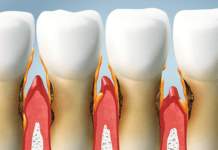For many, third-molar extractions are often a memorable experience. In some cases, it’s memorable due to the pain and discomfort associated with the procedure. Pain management is an essential aspect of dental care, including third molar extractions.
The American Dental Association recommends using nonsteroidal anti-inflammatory drugs (NSAIDs) as first-line therapy for the management of acute postoperative dental pain in adolescents and adults following simple or surgical tooth extractions instead of opioid analgesics.1,2 Yet, for many young adults, third molar extractions lead to their first encounter with opioid medications.3,4
Dentists often prescribe opioids to address concerns preemptively about uncontrolled pain during the weekend and overnight hours when follow-up care may not be readily available. This “just-in-case” approach occurs despite evidence to support the first-line use of nonopioid analgesics.3
Following the release of the Centers for Disease Control and Prevention guidelines for prescribing opioids in March 2016 (since updated in 2022), the American Dental Association released statements on opioid use for dental-related pain in October 2016 (since updated in 2018), the prescribing rate of opioids amongst dentists has decreased.2,4,5 However, dentists still remain among the top opioid prescribers in the United States, issuing over 8.9 million opioid prescriptions in 2022.3,4
While systematic reviews have shown that a combination of acetaminophen and ibuprofen is more effective than either alone, there is limited evidence directly comparing the combination with opioids for acute postsurgical pain. A study examined whether a combination of ibuprofen and acetaminophen is at least as effective as opioid analgesics after impacted mandibular third molar extraction surgery.3
The Study
The study design was a multisite, double-blind, randomized, stratified, noninferiority comparative effectiveness trial that evaluated patient-centered outcomes using two analgesic regimens after third-molar extraction. The analgesics included an opioid (5 mg hydrocodone with 300 mg acetaminophen) and a nonopioid (a combination of 400 mg of ibuprofen and 500 mg of acetaminophen).3
Exclusion criteria for the trial included, but were not limited to, medical contraindications for taking ibuprofen, acetaminophen, or opioids and a social history of addiction or substance abuse.3
A total of 1,815 healthy patients aged 18 and older with treatment planned for partial or complete bony impacted mandibular third molar extractions were included in the trial. Patients were required to take the first dose and then instructed to take their study analgesic every four to six hours as needed for pain. Any time during the clinical trial, patients could replace the study analgesic with over-the-counter ibuprofen.3
After surgery, nine withdrew consent, thirteen were lost to follow-up, and three were terminated due to hospitalization not associated with the trial. The final number of participants that completed the trial totaled 1,790 patients: 898 in the nonopioid group and 883 in the opioid group.3
Patients were instructed to track their pain intensity, pain interference, sleep patterns, adverse effects, satisfaction, medication use, and daily activities following the surgery.3 If pain control was inadequate, patients were advised to contact the study team for rescue medication (5 mg of oxycodone) if needed.3
Four to 14 days following surgery, patients returned for a postoperative follow-up visit. This follow-up visit included a clinical exam and questionnaire evaluating pain intensity, pain interference, sleep, and overall satisfaction. Patients were also asked to return the study materials (unused medication).3
Six months after treatment, a new search of the Prescription Data Monitoring Program (PDMP) was completed to assess any postoperative opioid use and offer addiction counseling if necessary.3
The Results
The primary outcome results of this trial showed that nonopioid pain medication was superior to opioid pain medication on the first and second day and night. Nonopioid pain medication was non-inferior on the third day and night and throughout the rest of the postoperative period.3
These results were based on the patient’s electronic diaries. Electronic diaries were updated morning and evening each day from the day of the surgery through the day of the postoperative follow-up visit. The patient’s entries were based on a pain scale from zero (no pain) to 10 (worst pain imaginable). Satisfaction was measured using a 5-point Likert scale from one (very satisfied) to five (very dissatisfied). Satisfaction data was collected at the postoperative follow-up visit.3
The secondary outcome measures were the need for rescue medication, pain interference, overall sleep quality, adverse events, number of opioid tablets returned, and additional opioid prescriptions acquired within six months after surgery. Secondary outcome measures were collected through various rating scales, such as 5-point and 3-point Likert scales.3
The results of the secondary outcomes showed that patients taking nonopioid pain medication had less need for rescue analgesics, reported less pain interference, fewer adverse effects, and better sleep quality. Patients who took nonopioid pain medication were also less likely to fill new opioid prescriptions within six months after surgery.3
In contrast, patients taking opioids were twice as likely to need rescue medication. Patients taking opioid pain medication, on average, returned 8.5 tablets of 20 after the trial.3
Patients taking nonopioid pain medication self-reported less fatigue, drowsiness, impaired concentration, nausea, diarrhea, dizziness, vomiting, headache, and weight gain. However, some did experience some adverse events with lower severity, such as fatigue, drowsiness, headache, and inability to concentrate.3
The strengths of this trial included the study design, real-world scenario, and the large sample size. Limitations include the exclusion of people with a personal or familial history of addiction or substance abuse. Additionally, patients were not restricted to a prescribed dosing schedule. The rationale for using as-needed dosing was to reduce the risk of potential addiction.3
Conclusion
The opioid crisis, responsible for an estimated 81,000 deaths annually in the United States, continues to be fueled by the overprescribing of opioids for managing postsurgical pain.3
Adolescents and young adults are often first exposed to opioids after third molar extractions. An estimated five million opioid-naïve patients first encounter opioids after third molar extractions.3 Adolescents and young adults are at an increased risk of developing opioid use disorder and experiencing overdose, even after a single exposure.1
In 2019, almost 40% of all opioid prescriptions by dentists were classified as high-risk. High-risk prescriptions include prescriptions written to opioid-naïve patients, prescriptions exceeding a three-day supply, daily dosage greater than 50 morphine milligrams, and opioid prescriptions that overlap benzodiazepines.1,2,4
The misconception that opioids provide superior pain relief compared to nonopioid alternatives influences both patient requests and surgeon prescribing habits. Despite substantial evidence supporting nonopioid options, many surgeons still prescribe opioids, often as a precautionary measure to manage pain outside of regular office hours.3
The results confirmed the aim of the clinical trial, indicating that a combination of ibuprofen and acetaminophen is at least as effective as the most commonly prescribed opioid for dental pain, with patients reporting a high level of satisfaction following third molar extraction surgery. At no time did hydrocodone outperform the nonopioid, and less pain was experienced by patients taking the ibuprofen and acetaminophen combination than those taking hydrocodone and acetaminophen.3
The researchers conclude, “Given the millions of unnecessary opioids dispensed every year and the associated addictive risk of opioids, we recommend the nonopioid combination as the standard of care for this patient population, thereby minimizing the number of opioids in circulation.”3
This conclusion aligns with the American Dental Association’s guidance, providing further support and evidence for the first-line use of nonopioid analgesics.1-3
Before you leave, check out the Today’s RDH self-study CE courses. All courses are peer-reviewed and non-sponsored to focus solely on high-quality education. Click here now.
Listen to the Today’s RDH Dental Hygiene Podcast Below:
References
- Carrasco-Labra, A., Polk, D.E., Urquhart, O., et al. Evidence-Based Clinical Practice Guideline for the Pharmacologic Management of Acute Dental Pain in Adolescents, Adults, and Older Adults: A Report from the American Dental Association Science and Research Institute, the University of Pittsburgh, and the University of Pennsylvania. J Am Dent Assoc. 2024; 155(2): 102-117.e9. https://jada.ada.org/article/S0002-8177(23)00672-4/fulltext
- Oral Analgesics for Acute Dental Pain. (2024, February 2). American Dental Association. https://www.ada.org/resources/ada-library/oral-health-topics/oral-analgesics-for-acute-dental-pain/
- Feldman, C.A., Fredericks-Younger, J., Desjardins, P.J., et al. Nonopioid vs Opioid Analgesics after Impacted Third-Molar Extractions: The Opioid Analgesic Reduction Study Randomized Clinical Trial. J Am Dent Assoc. https://jada.ada.org/article/S0002-8177(24)00639-1/fulltext
- Yan, C.H., Lee, T.A., Sharp, L.K., et al. Trends in Opioid Prescribing by General Dentists and Dental Specialists in the U.S., 2012-2019. Am J Prev Med. 2022; 63(1): 3-12. https://pmc.ncbi.nlm.nih.gov/articles/PMC9233039/
- Dowell, D., Ragan, K.R., Jones, C.M., et al. CDC Clinical Practice Guideline for Prescribing Opioids for Pain – United States, 2022. MMWR Recommendations and Reports. 2022; 71(No. RR-3): 1-95. https://www.cdc.gov/mmwr/volumes/71/rr/rr7103a1.htm












